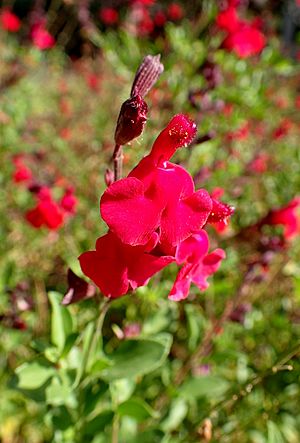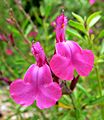Autumn sage facts for kids
Quick facts for kids Autumn sage |
|
|---|---|
 |
|
| Scientific classification | |
| Genus: |
Salvia
|
| Species: |
greggii
|
Salvia greggii, also known as autumn sage, is a beautiful plant that comes back year after year. It is a type of herbaceous plant, which means it has soft stems instead of woody ones. This plant grows naturally in a long, narrow area. This area stretches from southwest Texas, through the Chihuahuan Desert, and into the Mexican state of San Luis Potosí. You can usually find it growing in rocky soils. It grows at high elevations, from about 1,500 to 2,700 meters (5,000 to 9,000 feet) above sea level.
The plant was officially named and described in 1870. A botanist named Asa Gray named it after Josiah Gregg. Josiah Gregg was an explorer and writer who lived from 1806 to 1850. He found and collected this plant in Texas. Salvia greggii is very similar to another plant called Salvia microphylla. They often mix their genes to create new types of plants. Even though it's called "autumn sage," this plant actually blooms all through the summer and autumn!
Contents
What Does Salvia greggii Look Like?
Salvia greggii is a very diverse plant. This means that different plants of this species can look quite different from each other. There are many types of Salvia greggii that people have named. These plants can grow anywhere from about 30 centimeters (1 foot) to 1.2 meters (4 feet) tall. They are usually not as wide as they are tall. Some plants grow straight up, while others grow in a more rounded shape.
The leaves of Salvia greggii are usually a medium green color. They are smooth and often less than 2.5 centimeters (1 inch) long. If you crush a leaf, it has a spicy smell. The flowers also vary a lot in size and color. They can be from about 0.6 centimeters (0.25 inches) to 2.5 centimeters (1 inch) long. In the wild, you will most often see scarlet and red flowers. But you can also find them in many other colors. These include rose, white, pink, lavender, apricot, and violet.
Growing Salvia greggii in Gardens
This plant is very popular for growing in gardens. Many different types, called cultivars, have been developed.
- Furman's Red is a type from Texas. It has many dark red flowers that bloom in autumn.
- Big Pink has a large lower petal that is deep pink with a hint of lavender.
- Purple Pastel is a smaller type. It blooms again and again in the autumn.
- Cherry Chief grows well in the warm, humid southern United States.
- Desert Pastel has light apricot flowers with yellow stripes. It prefers mild weather.
- Other types include Alba, which has white flowers. Peach has bright red flowers. Strawberries and Cream has yellow and pink flowers.
Natural Hybrids: Salvia × jamensis
In 1991, plant explorers from England found natural hybrids in Mexico. These were mixes between S. greggii and S. microphylla. These mixed plants are called Salvia × jamensis. They are named after a nearby village called Jame. The explorers collected seeds from almost 30 different flower colors! Later, it was found that plants collected by a nursery from Texas were also forms of Salvia × jamensis.
These mixed plants usually look like S. greggii in height. However, they can have many different features. In the UK, two types of Salvia × jamensis have won awards. These are called ‘Javier’ and ‘Peter Vidgeon‘. They received the Royal Horticultural Society’s Award of Garden Merit.
Other types of Salvia plants have also been used to create garden varieties. Sometimes, it's hard to know exactly where some of these plants came from. As a group, these plants are often called Mexican salvias.
Images for kids
See also
 In Spanish: Salvia greggii para niños
In Spanish: Salvia greggii para niños



